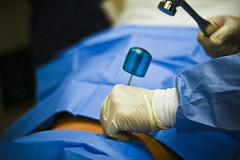How Effective Are Medical Treatments For Back Pain?
Monday, July 13, 2009
Jolie Bookspan, M.Ed, PhD, FAWM

Many well-known conventional treatments for injured athletes and military personnel came from ways to keep wounded combatants able to continue fire, not to maximize their long-term survival or later health.
Years of my career laboratory research was improving physical training for athletes and military, and developing injury protocols that were healthy, not just a remedy for the moment. I also found that much good sports medicine for athletic motion was never applied to the more common body motions needed all day. Not only can the athletes benefit, but everyone else. Many patients and readers have success using my improved non-surgical methods, and write us their stories (click for reader stories). Many more have success without writing about it. Other readers asked about various medical (surgical/drug) treatments, and why don't I use them.
Thank you to my colleague Fabrice Czarnecki. M.D. emergency room physician, for sending me a report, recently published in a prestigious medical journal. The work was a systematic review of the "benefits and harms of nonsurgical interventional therapies for low back and radicular pain."
The medical methods they looked at were local injections, botulinum toxin injection, prolotherapy, epidural steroid injection, facet joint injection, therapeutic medial branch block, sacroiliac joint injection, intradiscal steroid injection, chemonucleolysis, radiofrequency denervation, intradiscal electrothermal therapy, percutaneous intradiscal radiofrequency thermocoagulation, Coblation nucleoplasty, and spinal cord stimulation.
Their results: "For sciatica or prolapsed lumbar disc with radiculopathy, we found good evidence that chemonucleolysis is moderately superior to placebo injection but inferior to surgery, and fair evidence that epidural steroid injection is moderately effective for short-term (but not long-term) symptom relief. We found fair evidence that spinal cord stimulation is moderately effective for failed back surgery syndrome with persistent radiculopathy, though device-related complications are common. We found good or fair evidence that prolotherapy, facet joint injection, intradiscal steroid injection, and percutaneous intradiscal radiofrequency thermocoagulation are not effective. Insufficient evidence exists to reliably evaluate other interventional therapies.
What does all that mean? They summed it up in their conclusions: "Few nonsurgical interventional therapies for low back pain have been shown to be effective in randomized, placebo-controlled trials."
Report name: Nonsurgical interventional therapies for low back pain: a review of the evidence for an American pain society clinical practice guideline.
Published in Spine. 2009 May 1;34(10):1078-93.
Published in Spine. 2009 May 1;34(10):1078-93.
Medical reports on these methods (as well as general strengthening exercises) frequently show what is called a scattershot success - meaning if you try it on hundreds of people, it's bound to hit a few of them. Often these hits (moderate improvements) are about the same as chance or as time passing and the person heals on their own over the weeks of the treatment and recovery. Use those medical treatments if you believe in them and prefer them.
I prefer a direct approach:
- Instead of shots to anesthetize the area, or surgery to remove or fuse an area, retrain movement to be healthy so that you no longer injure the area and it can heal.
- Instead of medicines to mask the damage you cause, stop the damage.
- Stopping damage does not mean stopping movement, activity or fun. Use healthy body mechanics to become able to do more than before.
Continue Activities You Love
- Autumn Yard Work - Limiting the Person Instead of the Injury Again?
- When Did Health Become Thinking Out Of The Box?
- Why So Many Aerobics Injuries?
- What is "Fitness as a Lifestyle?"
Notice Damaging Body Mechanics
- Aren't You Supposed To Stick Your Behind Out to Sit Down or Do Squats?
- Prevent Back Surgery
- Sitting Badly Isn't Magically Healthy by Calling It a Hamstring Stretch
- What Does It Look Like to Not Use Abdominal Muscles?
- Simulation Suit To Feel the Pain of Osteoarthritis
- Are You Making Your Exercise Unhealthy?
Fixing Damage Without Surgeries, Injections, or Drugs
- Innovation in Abdominal Muscles
- Surgery for Knee Arthritis, Meniscus, Unnecessary
- Stomach Acid Drugs Increase Osteoporosis and Hip Fractures
- Studies Say Back Surgery Not Needed
- Anterior Cruciate Ligament (ACL) Surgery Unnecessary
- Fix Disc Pain Without Surgery
- FDA Orders Suicide Risk Warning for Common Back Pain and Migraine Drugs, and Others
- Doctor Fakes Benefits in 21 Pain Pill Studies
Coming next - Common, Missed Cause of MusculoSkeletal Pain - Your Drugs.---Questions come in by hundreds. I make posts from fun mail. Before asking more, see if your answers are already here - click labels under posts, links in posts, archives at right, and the Fitness Fixer Index. Why not try fun stuff, then contribute! Read success stories of these methods and send your own.
Subscribe to The Fitness Fixer, free. Click "updates via e-mail" (under trumpet) upper right.
See Dr. Bookspan's Books, take a Class, get certified - DrBookspan.com/Academy.
Labels: drugs, fix pain, lower back, military fitness, surgery

1 Comments:
At Tuesday, August 11, 2009 5:53:00 PM, Cockroach Catcher said…
Cockroach Catcher said…
Found your site via Grand Rounds.
Very interesting.
The Cockroach Catcher
Post a Comment
<< Home